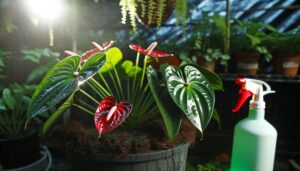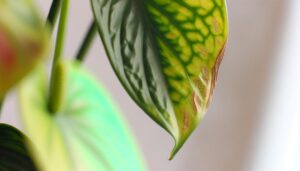10 Tips to Help Anthurium Plants Grow New Leafs and Flowers
To help your anthurium plants flourish with new leaves and flowers, place them in bright, indirect sunlight and avoid direct exposure. Water when the top inch of soil is dry, using a well-draining mix with peat moss and perlite.
Maintain humidity at 70-80% using a hygrometer, and group plants for a moisture microenvironment. Keep temperatures stable between 70°F and 85°F, avoiding drafts.
Trim dead foliage, control pests with insecticidal soap, and repot every 1-2 years using a mix of orchid bark and peat moss. Apply a balanced high-phosphorus fertilizer bi-weekly.
For more intricate details, continue exploring.

Key Takeaways
- Provide bright, indirect sunlight and avoid direct sunlight to prevent leaf scorching.
- Maintain humidity levels between 70-80% using a humidifier or pebble trays.
- Water when the top inch of soil feels dry to avoid overwatering and root rot.
- Use a well-draining potting mix rich in organic matter like peat moss and perlite.
- Apply a balanced fertilizer high in phosphorus bi-weekly during the growing season.
Optimal Light Conditions
To maximize the growth and flowering of your Anthurium plants, place them in an area where they receive bright, indirect sunlight for best outcomes. Direct sunlight can scorch the leaves, leading to photodamage and hindered photosynthesis. Ideally, situate your Anthurium near an east or north-facing window to guarantee it gets ample light without exposure to harmful UV rays.
If natural light is insufficient, consider supplementing with fluorescent grow lights, keeping them at least 12 inches away to prevent overheating. Monitor the light intensity using a light meter; prime levels range between 1,500 and 2,500 foot-candles. Regularly rotate the plant to guarantee even light distribution, promoting uniform leaf and flower development.
Following these guidelines will notably enhance your Anthurium's overall health.
Proper Watering Techniques
Maintain your Anthurium's consistent moisture levels by watering when the top inch of soil feels dry.
Avoid overwatering, as excessive moisture can lead to root rot and other fungal issues.
Use well-draining soil and pots with drainage holes to regulate water retention effectively.
Consistent Moisture Levels
Maintaining consistent moisture levels is crucial for Anthurium plants, as they thrive in a balanced environment where the soil is evenly moist but not waterlogged.
To achieve this, follow these detailed steps:
- Use Well-Draining Soil: Guarantee your soil mix includes components like perlite and peat moss to facilitate proper drainage and aeration.
- Water Regularly: Establish a routine, typically watering every 5-7 days, but adjust based on humidity and temperature variations.
- Check Soil Moisture: Insert your finger about an inch into the soil; water if it feels dry, but let it be if it's still moist.
- Employ a Humidity Tray: Place a humidity tray under the pot to maintain ambient moisture levels, especially in drier climates.
Avoid Overwatering Risks
Overwatering poses significant risks to Anthurium plants, leading to root rot and fungal infections that can hinder their growth. To avoid these issues, you should make sure the soil is well-draining and water the plant only when the top inch of soil feels dry. Use a moisture meter for precise measurement.
| Indicator | Action | Frequency |
|---|---|---|
| Top inch dry | Water lightly | Check weekly |
| Soil soggy | Withhold watering | Immediate |
| Yellow leaves | Reduce watering | Monitor bi-weekly |
| Root rot signs | Repot immediately | As needed |
Don't let the plant sit in standing water, and make sure the pot has drainage holes. Following these guidelines will help maintain the ideal soil moisture, promoting healthy growth and vibrant blooms.
Ideal Soil Mix
A well-draining soil mix rich in organic matter is important for promoting healthy root development and vibrant growth in Anthurium plants. You'll want to create a substrate that mimics their natural tropical environment.
Here's a recommended mix:
- Peat Moss: Provides moisture retention and aeration. Use it as the primary component.
- Pine Bark: Enhances drainage and adds structure, preventing soil compaction.
- Perlite: Improves aeration and prevents waterlogging, essential for root health.
- Charcoal: Acts as a natural filter, removing toxins and maintaining soil freshness.
Combine these ingredients in equal parts to create an ideal growing medium. This blend ensures that water drains efficiently while retaining enough moisture and nutrients for your Anthurium's needs.
Humidity Requirements
To optimize Anthurium growth, you'll need to maintain ideal humidity levels between 70-80%. Guarantee moisture consistency by regularly checking the ambient humidity and using a hygrometer.
For effective humidity-boosting techniques, consider using a humidifier, misting the leaves, or placing the plant on a pebble tray with water.
Ideal Humidity Levels
Maintaining ideal moisture levels, ideally between 60% and 80%, is crucial for the healthy growth and development of Anthurium plants. These tropical plants thrive in high-moisture environments, mimicking their natural habitat.
To achieve best moisture levels, follow these steps:
- Use a Humidifier: Position a humidifier near your Anthurium to consistently maintain the desired moisture range.
- Group Plants Together: Clustering plants can create a microenvironment with increased moisture through transpiration.
- Misting: Lightly mist the leaves daily with distilled water to boost moisture, but avoid oversaturation.
- Moisture Tray: Place a tray filled with water and pebbles beneath the pot, ensuring the pot's base doesn't sit directly in the water.
These methods will guarantee your Anthurium receives the moisture it needs.
Maintaining Moisture Consistency
Ensuring consistent humidity levels is essential for the best health and growth of your Anthurium plants. These tropical plants thrive in environments with 60-80% humidity. Regular monitoring and adjustments can prevent issues like leaf browning and stunted growth. Use a hygrometer to accurately measure ambient humidity. Place the plants away from direct air conditioning or heating vents, which can cause rapid moisture fluctuations.
| Humidity Level | Plant Response |
|---|---|
| 40% or lower | Leaf browning, slow growth |
| 40-50% | Minimal growth, stress signs |
| 50-60% | Moderate growth, some stress |
| 60-80% | Best growth, healthy leaves |
| Above 80% | Risk of fungal diseases |
Humidity-Boosting Techniques
Boost your Anthurium's humidity levels by employing techniques such as misting, using humidity trays, and deploying a humidifier to maintain the ideal 60-80% range. Consistent humidity is essential for peak growth and vibrant blooms. Here's how you can achieve this:
- Misting: Use distilled water to mist your plant daily, making sure water droplets are fine to avoid leaf damage.
- Humidity Trays: Place a shallow tray filled with water and pebbles beneath your plant. Ensure the pot isn't directly in water to prevent root rot.
- Humidifier: Invest in a quality humidifier to maintain a controlled environment, especially during dry seasons.
- Grouping Plants: Cluster your Anthurium with other plants to create a micro-environment with naturally higher humidity levels.
Temperature Control
Perfect temperature control is crucial for the healthy development and blooming of Anthurium plants, requiring consistent warmth and avoidance of cold drafts. Maintain an ambient temperature between 70°F and 85°F (21°C to 29°C) during the day, and ensure it doesn't drop below 60°F (15°C) at night.
Sudden temperature fluctuations can stress the plant, hindering growth and flower production. Position your Anthurium away from windows or doors that are frequently opened, as these can introduce cold drafts. Utilize a thermometer to monitor the room temperature closely, and employ a space heater if necessary to maintain ideal conditions.
Fertilization Schedule
A well-planned fertilization schedule is crucial for providing Anthurium plants with the necessary nutrients to thrive and produce vibrant flowers.
You should use a balanced, water-soluble fertilizer with an N-P-K ratio of 20-20-20.
Follow these detailed steps:
- Frequency: Fertilize every 6-8 weeks during the growing season (spring and summer).
- Concentration: Dilute the fertilizer to half the recommended strength to prevent root burn.
- Application Method: Apply the solution directly to the soil, avoiding the leaves to prevent foliar damage.
- pH Monitoring: Check the soil pH stays between 5.5 and 6.5 for best nutrient absorption.
Pruning Practices
When pruning your Anthurium, start by removing any dead leaves to prevent disease and decay.
Next, trim spent flowers to redirect the plant's energy towards producing new blooms.
Remove Dead Leaves
Proper pruning techniques are essential for removing dead leaves from Anthurium plants to promote healthy growth and flowering. Start by sterilizing your pruning shears to prevent pathogen transmission.
Carefully examine the plant and identify leaves that are yellowing, browning, or wilting. Follow these steps:
- Identify Dead Leaves: Look for leaves that display chlorosis or necrosis.
- Sterilize Tools: Use isopropyl alcohol to sterilize shears, ensuring no cross-contamination.
- Cut at the Base: Prune dead leaves at the base of the petiole, close to the main stem.
- Dispose Properly: Discard pruned leaves away from the plant to prevent fungal spread.
Trim Spent Flowers
To encourage new blooms and maintain plant health, trim spent flowers by cutting the flower stalk at the base where it meets the main stem, using disinfected pruning shears. This practice helps redirect the plant's energy toward developing new growth and flowers.
Confirm your shears are disinfected with isopropyl alcohol to prevent bacterial or fungal infections. Make a clean cut to avoid damaging the main stem—this promotes quicker healing.
Regularly inspect your Anthurium for spent flowers, which appear wilted or discolored. Removing these promptly prevents the plant from wasting nutrients on non-productive parts.
Shape for Growth
Prune your Anthurium strategically to shape its growth, ensuring robust health and best flowering. Proper pruning encourages the plant's natural form and enhances nutrient distribution.
Follow these steps for effective pruning:
- Identify Diseased Leaves: Remove any yellowing, wilted, or diseased leaves to prevent pathogen spread and redirect energy to healthy growth.
- Trim Spent Flowers: Cut back flower stalks once they've faded, promoting new blooms and reducing unnecessary energy expenditure.
- Cut Above Nodes: Make cuts just above a leaf node or bud, using sterilized pruning shears. This encourages new shoots and maintains plant structure.
- Moderate Pruning: Avoid excessive pruning; removing more than 20% of the plant at once can stress your Anthurium, impacting its vitality and flowering potential.
Pest Management
Effectively managing pests like aphids, spider mites, and scale insects is essential for maintaining the health and vigor of your Anthurium plants.
First, inspect your plants regularly using a magnifying glass to detect early infestations.
For aphid control, apply a diluted solution of insecticidal soap, ensuring thorough coverage on the undersides of leaves.
Spider mites can be managed by increasing humidity levels and using miticides if necessary.
Scale insects require manual removal with a cotton swab dipped in rubbing alcohol, followed by the application of neem oil to prevent recurrence.
Always isolate infected plants to avoid cross-contamination.
Regularly clean your growing area and tools to reduce pest harborage.
Consistent vigilance and appropriate interventions will keep your Anthurium thriving.
Repotting Guidelines
Repotting your Anthurium plants every 1-2 years is essential for maintaining ideal root health and ensuring vigorous growth. Start by selecting a pot that's 1-2 inches larger in diameter than the current one. Use a well-draining potting mix composed of equal parts orchid bark, perlite, and peat moss.
Follow these steps:
- Remove the Plant: Gently extract the plant from its current pot, taking care not to damage the roots.
- Trim Roots: Prune any dead or rotting roots using sterilized scissors to prevent disease.
- Reposition: Place the Anthurium in the new pot, ensuring the root ball is centered.
- Backfill: Fill around the root ball with the prepared potting mix, pressing lightly to eliminate air pockets.
Repotting promotes ideal nutrient absorption and root expansion.
Encouraging Blooms
After repotting, turn your attention to optimizing conditions that stimulate Anthurium blooms, such as maintaining consistent humidity levels, providing bright indirect light, and applying a balanced fertilizer high in phosphorus. Aim for a humidity level of 60-80%.
Use a hygrometer to monitor and adjust with a humidifier or misting. Place your Anthurium in a location with bright, indirect sunlight, avoiding direct rays that can scorch leaves.
For fertilization, select a balanced fertilizer with a higher phosphorus content (e.g., 10-30-10). Apply it bi-weekly during the growing season, diluting it to half the recommended strength to prevent root burn.
Conclusion
With these 10 tips, you'll cultivate anthuriums that flourish like a well-tuned orchestra, harmonizing vibrant leaves and stunning blooms.
By mastering light, water, soil, humidity, and temperature, alongside vigilant pruning, pest management, and timely repotting, you'll guarantee your plants thrive.
Remember, each element works together, creating a symphony of growth.
Follow these detailed instructions and watch your anthuriums transform into botanical masterpieces, radiating health and beauty.






